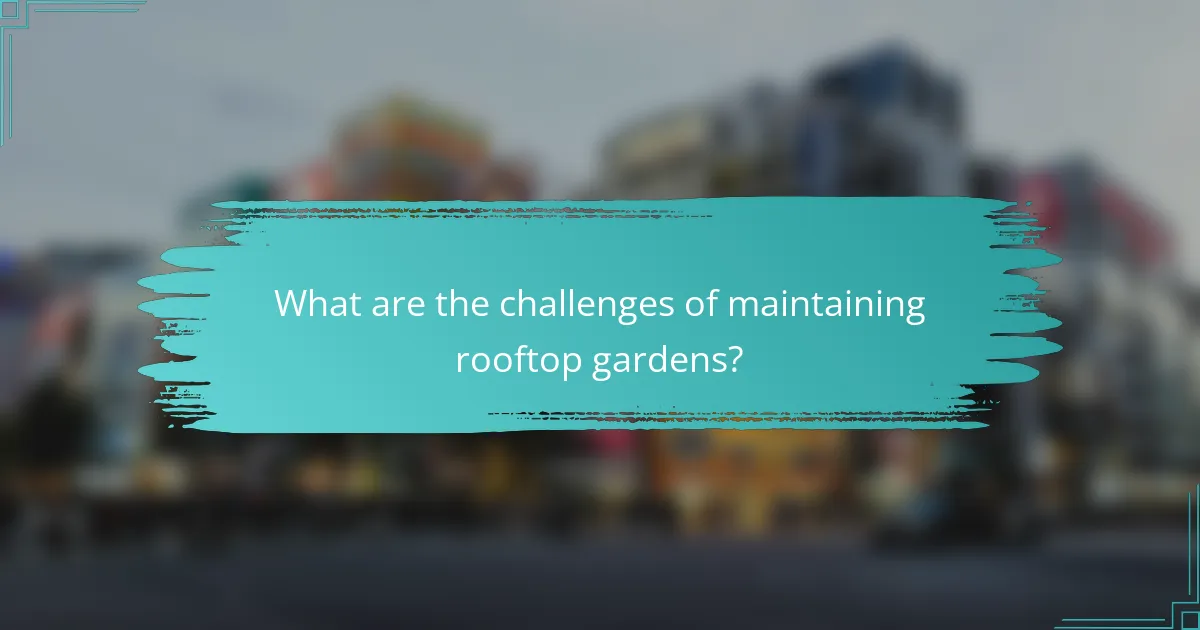Community rooftop gardens are pivotal in transforming urban landscapes by introducing green spaces that significantly improve residents’ quality of life. Beyond their aesthetic appeal, these gardens foster social cohesion, enhance community interaction, and provide fresh food sources, ultimately contributing to environmental sustainability and increased property values.

How do community rooftop gardens transform urban areas?
Community rooftop gardens significantly transform urban areas by creating green spaces that enhance the quality of life for residents. These gardens not only provide aesthetic benefits but also contribute to environmental improvements and social cohesion within neighborhoods.
Enhance green space accessibility
Community rooftop gardens increase access to green spaces in densely populated urban areas where traditional parks may be limited. By utilizing rooftops, these gardens provide residents with a place to relax, socialize, and engage in gardening activities without needing to travel far.
For example, a rooftop garden in a city center can serve as a communal area for residents to gather, fostering a sense of community. This accessibility is crucial in urban environments where natural landscapes are often scarce.
Improve air quality
Rooftop gardens contribute to improved air quality by filtering pollutants and absorbing carbon dioxide. Plants in these gardens can capture particulate matter and other harmful substances, leading to cleaner air for nearby residents.
In urban settings, where air pollution levels can be concerning, the presence of greenery helps mitigate these effects. Studies suggest that even small rooftop gardens can make a noticeable difference in local air quality over time.
Support biodiversity
Community rooftop gardens play a vital role in supporting urban biodiversity by providing habitats for various species, including birds, insects, and pollinators. These gardens can serve as crucial green corridors in cities, connecting fragmented habitats and encouraging wildlife movement.
Incorporating native plants into rooftop gardens can enhance this effect, as they are better suited to local ecosystems and attract a wider range of species. This biodiversity not only enriches the urban environment but also contributes to ecological resilience.
Reduce urban heat island effect
Rooftop gardens help mitigate the urban heat island effect by cooling buildings and surrounding areas. Vegetation absorbs sunlight and provides shade, which can lower temperatures in urban environments that often experience higher heat levels due to concrete and asphalt surfaces.
Implementing rooftop gardens can reduce energy costs associated with air conditioning, as cooler buildings require less energy to maintain comfortable temperatures. This is particularly beneficial in cities where summer heat can be intense and prolonged.

What are the neighborhood benefits of rooftop gardens?
Rooftop gardens offer significant neighborhood benefits, enhancing community interaction, providing fresh food sources, and increasing property values. These gardens transform underutilized spaces into vibrant areas that foster social connections and environmental sustainability.
Foster community engagement
Rooftop gardens serve as communal spaces where residents can gather, collaborate, and participate in gardening activities. These interactions help build relationships among neighbors, creating a sense of belonging and community pride.
Organizing events such as gardening workshops, potlucks, or seasonal festivals can further strengthen community ties. Engaging local schools or organizations can also promote educational opportunities related to sustainability and healthy living.
Provide local food sources
Rooftop gardens can produce a variety of fruits, vegetables, and herbs, offering fresh and organic food options to local residents. This not only reduces the carbon footprint associated with transporting food but also encourages healthier eating habits.
Community members can participate in growing their own produce, which fosters a sense of ownership and responsibility. Additionally, surplus harvests can be shared with local food banks or markets, benefiting those in need.
Increase property values
Investing in rooftop gardens can lead to increased property values in urban areas. Properties with green spaces are often more attractive to potential buyers, leading to higher demand and, consequently, higher prices.
Studies suggest that homes near green spaces can see property value increases of 10-20%. This trend is particularly relevant in densely populated cities where outdoor space is limited, making rooftop gardens a valuable asset for homeowners and developers alike.

How can cities implement rooftop garden initiatives?
Cities can implement rooftop garden initiatives by developing structured programs that encourage participation from building owners, residents, and local businesses. These programs often include financial incentives, partnerships with community organizations, and supportive zoning regulations to facilitate the creation and maintenance of green spaces on rooftops.
Incentivize through grants
Offering grants can significantly boost the establishment of rooftop gardens. Cities can allocate funds to property owners who invest in green roofs, covering a portion of installation costs, which can range from several thousand to tens of thousands of dollars depending on the size and complexity of the project.
Additionally, tax incentives or rebates can be introduced to encourage ongoing maintenance and sustainability efforts. This financial support not only makes rooftop gardens more accessible but also promotes long-term environmental benefits.
Partner with local organizations
Collaboration with local organizations, such as gardening clubs, environmental nonprofits, and educational institutions, can enhance rooftop garden initiatives. These partnerships can provide expertise, resources, and volunteer support, making it easier to launch and sustain projects.
For example, a city might partner with a local university’s agricultural program to offer workshops on urban gardening techniques, thereby fostering community engagement and knowledge sharing. Such collaborations can also help in securing additional funding and resources.
Establish zoning regulations
Implementing supportive zoning regulations is crucial for the success of rooftop gardens. Cities can revise existing codes to allow for green roofs in new developments or renovations, ensuring that building designs incorporate these spaces.
Regulations might include requirements for a certain percentage of green space on rooftops or guidelines on structural modifications needed to support garden installations. Clear zoning laws can streamline the approval process and encourage more property owners to participate in rooftop gardening initiatives.

What are the best practices for designing rooftop gardens?
Designing rooftop gardens effectively involves selecting appropriate plants, ensuring the structure can support the garden’s weight, and implementing efficient water management systems. These best practices help maximize the benefits of rooftop gardens while minimizing potential issues.
Choose suitable plant species
Selecting the right plant species is crucial for the success of rooftop gardens. Opt for drought-resistant plants that can thrive in limited soil depth and fluctuating temperatures. Native plants are often a great choice as they require less maintenance and are better adapted to local conditions.
Consider the sunlight exposure and wind conditions of the rooftop when choosing plants. For instance, succulents and herbs can perform well in sunny spots, while ferns and shade-tolerant plants are suitable for areas with less direct sunlight.
Ensure structural integrity
Before installing a rooftop garden, it’s essential to assess the building’s structural integrity. Consult with a structural engineer to determine if the roof can support the additional weight of soil, plants, and water. Most rooftops can handle around 15-20 pounds per square foot, but this varies by building.
Reinforcements may be necessary for older buildings or those with existing issues. Regular inspections can help identify potential problems before they escalate, ensuring the longevity of both the garden and the building.
Incorporate water management systems
Effective water management is vital for rooftop gardens to prevent waterlogging and ensure plants receive adequate moisture. Implementing a drainage system is crucial; consider using lightweight soil mixes that promote drainage while retaining moisture.
Rainwater harvesting systems can also be beneficial. Collecting rainwater for irrigation reduces water costs and promotes sustainability. Additionally, drip irrigation systems can help deliver water directly to plant roots, minimizing waste and ensuring efficient use of resources.

What are the challenges of maintaining rooftop gardens?
Maintaining rooftop gardens presents several challenges, including ensuring adequate irrigation and managing pest control. These factors are crucial for the health and productivity of the plants, requiring careful planning and ongoing attention.
Address irrigation needs
Effective irrigation is essential for rooftop gardens, as they often lack natural water sources. Consider installing a drip irrigation system to deliver water directly to the roots, minimizing waste and ensuring consistent moisture levels.
Monitor weather patterns and adjust watering schedules accordingly. During hot summer months, rooftop gardens may require watering several times a week, while cooler seasons may reduce this need. A rainwater harvesting system can also be beneficial, collecting rain for irrigation use.
Manage pest control
Pest control in rooftop gardens can be challenging due to limited space and the potential for rapid infestations. Regularly inspect plants for signs of pests and diseases, and consider using organic pest control methods to minimize chemical exposure.
Encourage beneficial insects, such as ladybugs and lacewings, which can help keep pest populations in check. Additionally, rotating crops and planting companion plants can enhance biodiversity and reduce the likelihood of pest outbreaks.
